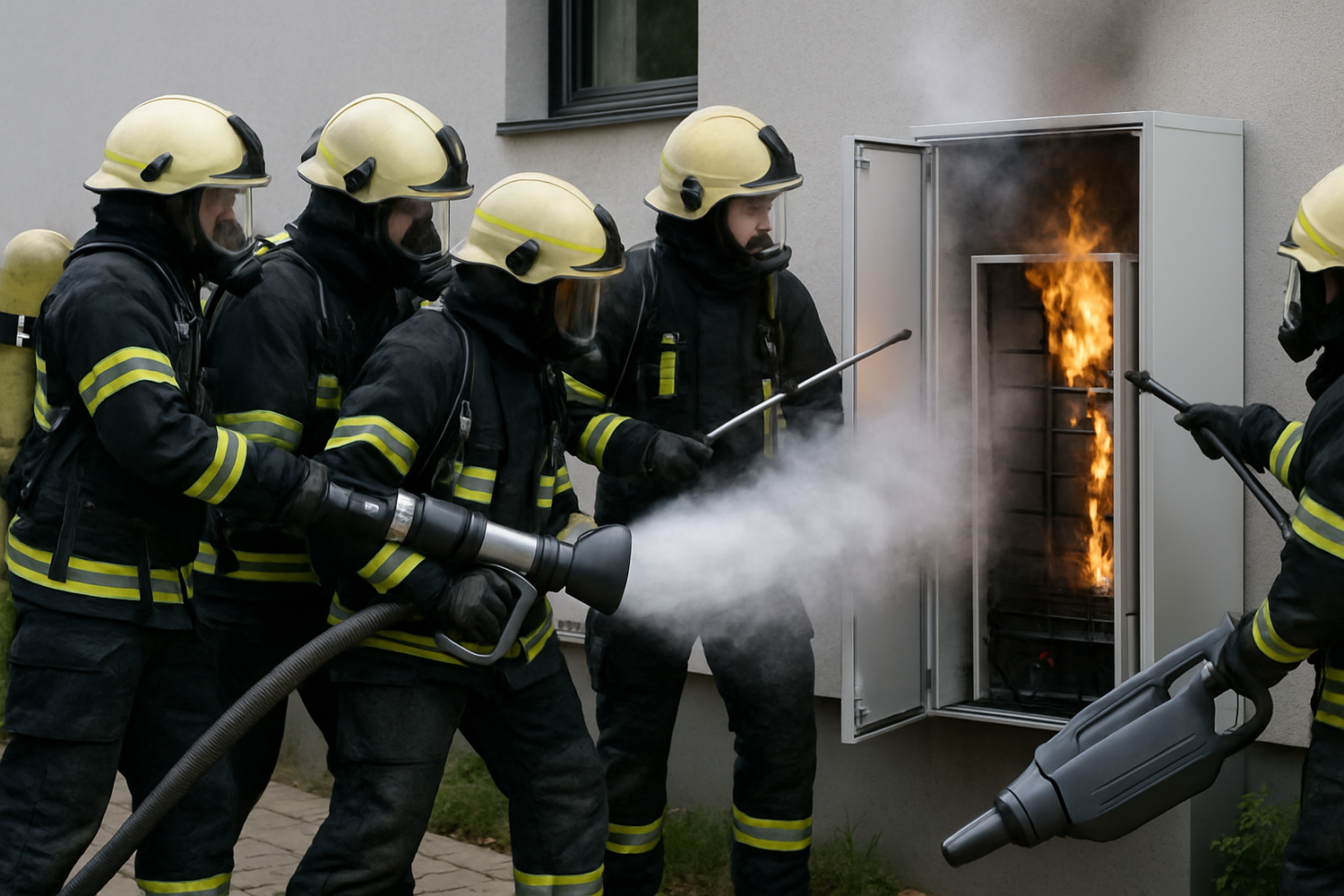Energy storage systems are pivotal for achieving energy independence. However, the concentration of energy in batteries, particularly lithium-ion types, introduces fire risks that require specialized knowledge. Understanding the appropriate emergency response for battery fires is not just a technical requirement but a critical safety protocol for homeowners and professionals alike. This guide provides a detailed overview of how to prepare for and react to these challenging situations.
Understanding the Nature of Lithium-Ion Battery Fires
Lithium-ion battery fires are unlike conventional fires. They are chemical fires driven by a process called thermal runaway. This is a self-sustaining chain reaction where an increase in temperature causes further increases in temperature, often with dangerous consequences. Knowing the unique characteristics of these fires is the first step in effective emergency containment.
What is Thermal Runaway?
Thermal runaway begins when a single battery cell fails due to damage, a manufacturing defect, or overcharging. This failure generates heat, which can trigger adjacent cells to fail, creating a domino effect. During this process, batteries can release flammable and toxic gases, leading to fire, explosion, or both. Recognizing the early signs is crucial. You can learn more about The Ultimate Guide to Lithium Battery Thermal Runaway for an in-depth explanation.
Key Hazards: Gas, Heat, and Reignition
The primary hazards associated with lithium-ion battery fires are intense heat, the release of toxic and flammable gases, and the high potential for reignition. Even after the initial flames are extinguished, the cells can continue to undergo thermal runaway and reignite, sometimes hours or even days later. This makes post-fire monitoring as important as the initial extinguishment efforts.
Pre-Incident Planning: The First Line of Defense
Effective battery fire emergency response begins long before an incident occurs. Proper planning, installation, and adherence to safety standards are fundamental. According to the U.S. Department of Energy, robust safety protocols and standards are key to mitigating risks associated with energy storage systems.
Adherence to Safety Standards
Standards like NFPA 855 provide comprehensive guidelines for the installation of stationary energy storage systems, covering aspects like location, fire suppression, and ventilation. Compliance with these standards is not just a regulatory hurdle; it's a foundational safety measure. For example, NFPA 855 mandates specific spacing between units and requires a hazard mitigation analysis to ensure risks are properly assessed and managed.
System Design and Safer Chemistries
Choosing the right battery chemistry is a significant factor in fire safety. Lithium Iron Phosphate (LiFePO4) batteries, for instance, have a more stable chemical structure than other lithium-ion chemistries, making them less prone to thermal runaway. Our LiFePO4 batteries are engineered with safety as a priority, offering high performance and reliability. For a detailed comparison, see our analysis on LiFePO4 vs. Other Lithium Batteries: A Fire Safety Comparison. Additionally, a well-designed Battery Management System (BMS) is critical for monitoring cell temperature, voltage, and current to prevent conditions that could lead to a fire.
Developing an Emergency Response Plan (ERP)
Every installation should have a clear, actionable Emergency Response Plan. This plan should be developed in coordination with local first responders and include details such as system shutdown procedures, emergency contacts, and a site map indicating the location of the energy storage system. A step-by-step guide can be found in our article on creating A Step-by-Step Emergency Plan for Lithium Battery Fires.
Immediate Actions During a Battery Fire
If you are faced with a battery fire, your immediate actions can significantly impact the outcome. Personal safety is the absolute priority. Knowing what to do during a battery fire is critical for anyone with a home energy storage system.
Step 1: Evacuate and Alert
The moment you suspect a battery fire—indicated by smoke, hissing sounds, a bulging battery casing, or a distinct odor—evacuate the area immediately. Alert all occupants and call 911. Clearly state that you have a lithium-ion battery fire, as this information is vital for the responding fire department to deploy the correct strategy and equipment. For more on identifying these initial warnings, read What Are the First Signs of a Lithium Battery Overheating?.
Step 2: Isolate if Possible and Safe
If it is safe to do so without risking personal injury, disconnect the energy storage system from all power sources. This may involve shutting off breakers connected to the solar panels, the inverter, and the main electrical panel. Do not attempt to touch or move a battery that is smoking or on fire.
Step 3: Do Not Use the Wrong Extinguisher
Conventional fire extinguishers may not be effective. While a standard ABC dry chemical extinguisher might knock down the initial flames, it will not cool the battery cells enough to stop thermal runaway. Using a Class D extinguisher, designed for combustible metals, is also incorrect for most consumer-grade lithium-ion batteries as they contain little to no free lithium metal.
Professional Fire Suppression Techniques
Fighting a lithium-ion battery fire is a task for trained professionals. Fire departments are increasingly trained in specific techniques for these events, which differ significantly from traditional firefighting.
The Role of Water: Cooling is Key
The primary strategy for combating a lithium-ion battery fire is cooling. Firefighters will use large and sustained amounts of water to lower the temperature of the battery pack and stop the thermal runaway process. This can require thousands of gallons of water over several hours. The goal is not just to extinguish the flames but to cool the cells below their critical reaction temperature.
Specialized Suppression Agents
While water is the most common cooling agent, research is ongoing into more specialized agents. Water mist systems, sometimes with additives, have shown to be effective in suppressing fires and cooling cells. Clean agent systems are also used, especially in enclosed spaces, as they suppress the fire without leaving a residue but may not provide sufficient cooling to prevent reignition.
Containment and Post-Fire Management
After the fire is seemingly out, the danger is not over. The risk of reignition is high. First responders will continue to monitor the battery's temperature, often using thermal imaging cameras. The unit may be submerged in water or moved to a safe, isolated location for observation. A comprehensive overview of these procedures is available in our guide on How to Respond to a Home Battery Storage System Fire.
The International Energy Agency (IEA) highlights the growing importance of grid-scale energy storage and the associated need for advanced safety protocols to ensure system reliability and public safety.
Prevention is the Best Strategy
While knowing how to respond to a fire is essential, preventing one from starting is paramount. Regular maintenance, proper usage, and a high-quality installation are your best defenses.
Best Practices for Battery Safety
To minimize risks, follow these best practices:
- Ensure your system is installed by a certified professional.
- Follow all manufacturer guidelines for operation and maintenance.
- Keep the area around your battery storage system clear of flammable materials.
- Regularly inspect your system for any signs of damage or malfunction.
- Avoid charging or operating batteries in extreme temperatures.
For more actionable tips, explore our article on 7 Ways to Prevent Your Solar Energy Storage System from Firing.
The ANERN Commitment to Safety
We are dedicated to providing reliable and scalable energy solutions that empower our customers. Our home energy storage systems integrate high-performance, safe LiFePO4 lithium batteries with advanced hybrid inverters. We prioritize safety through rigorous design, manufacturing, and quality control processes, helping you achieve energy independence with confidence.
It's also important to be aware of common misconceptions. Many myths circulate about battery fires, and understanding the facts is key to proper safety. You can learn more by reading Debunked: Common Myths About Lithium-Ion Battery Fires.
Moving Forward with Confidence
The adoption of solar and energy storage is a significant step towards a sustainable future. While the risk of battery fires is real, it is also manageable. Through a combination of superior technology like LiFePO4, adherence to stringent safety standards, comprehensive pre-incident planning, and a clear understanding of emergency response procedures, the safety of energy storage systems can be effectively managed. By staying informed and prepared, you can enjoy the benefits of your solar energy system with peace of mind.
Disclaimer: This article is for informational purposes only and does not constitute legal or professional advice. Always consult with qualified professionals and your local fire department for guidance on fire safety and emergency response planning.





Leave a comment
All comments are moderated before being published.
This site is protected by hCaptcha and the hCaptcha Privacy Policy and Terms of Service apply.